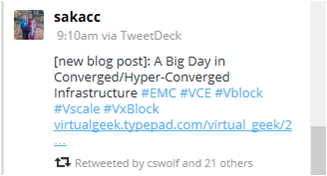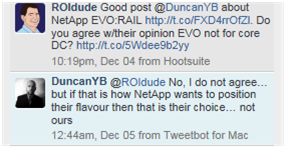Nearly every leading legacy and startup datacenter hardware player has, or has announced, a Hyper-Converged Infrastructure (HCI) solution. But how do they really see HCI?
Yesterday provides some clues: An article from The Register discusses declining array sales; a blog post from EMC President of Global Systems Engineering, Chad Sakac, covers the new VCE HCI announcements; and a post from Pure Storage Chief Evangelist, Vaughn Stewart, makes a case for why HCI won’t replace storage arrays.
Disk Array Disarray
Chris Mellor’s article in The Register, Disk array devastation: New-tech onslaught tears guts from trad biz, reveals what is perhaps a significant reason that the storage manufacturers are entering the HCI market, “An EMC chart shows a steep decline in legacy SAN drive array sales.” The article goes on to say, “EMC sees the market moving “toward converged and hyperconverged systems, all-flash arrays and purpose-built back-up appliances.”
Chad Sakac’s post, “A big day in converged infrastructure,” discusses how EMC’s Vblock is helping the company address the sea change in storage. The post was not clear (at least to me) about how Vblocks will incorporate HCI – but Sakac left no doubt that they will, “This is the experience of an ‘engineered system’ like a Vblock or a VxBlock – whether it’s converged, or hyper-converged.”
Sakac also references both VSPEX Blue and EVO:Rack – both of which, along with Vblock, are now part of EMC’s VSPEX converged infrastructure division.
Pure Storage
Vaughn Stewart, former Cloud Evangelist atNetApp, wrote an interesting post yesterday about HCI, Hyper-Converged Infrastructures are not Storage Arrays. Stewart starts off endorsing HCI, “I’m a Huge Fan of Hyper-Converged Infrastructures,” but then quickly changes course and relegates the technology to “the low end storage array market.”
Stewart goes on to outright bash HCI – making an argument that data mirroring on a virtual disk basis is inferior to RAID (a technology invented in 1987). Stewart also presents lots of calculations claiming low storage utilization and other supposed HCI limitations.
I’m not going to address Stewart’s claims in this post; they may very well be applicable to other HCI players. They do not apply to Nutanix. Josh Odgers (aka FUDbuster) is writing a post in response to Vaughn’s piece.
Stewart made no mention in his article about Pure’s own apparent plans to introduce an HCI solution.
NetApp
Since NetApp’s Mike Riley wrote the post, VSAN and Hyper-Converged will Hyper-Implode, last June, it’s unfair to assume that it reflects NetApp’s current day perspective on HCI. On the other hand, even when NetApp unveiled ONTAP EVO:Rail a few months ago, the company made it clear that HCI, without NetApp storage, is not suitable for the enterprise.
A Question of Mindset
Sakac, Stewart and Riley are among the most respected technologists in our industry. But they also work for array manufacturers and naturally see the world through the lens of protecting legacy business.
The tremendous gain in mind share of HCI is driving the storage players to enter the market. This further validates the technology even though the array manufacturers position HCI as a low-end alternative to disk or flash arrays.
Nutanix, on the other hand, eats breaths and sleeps web-scale HCI in all that we do. It’s a question of mind set. The array manufacturers offer customers yet another storage option. Nutanix is revolutionizing the virtualized datacenter.



